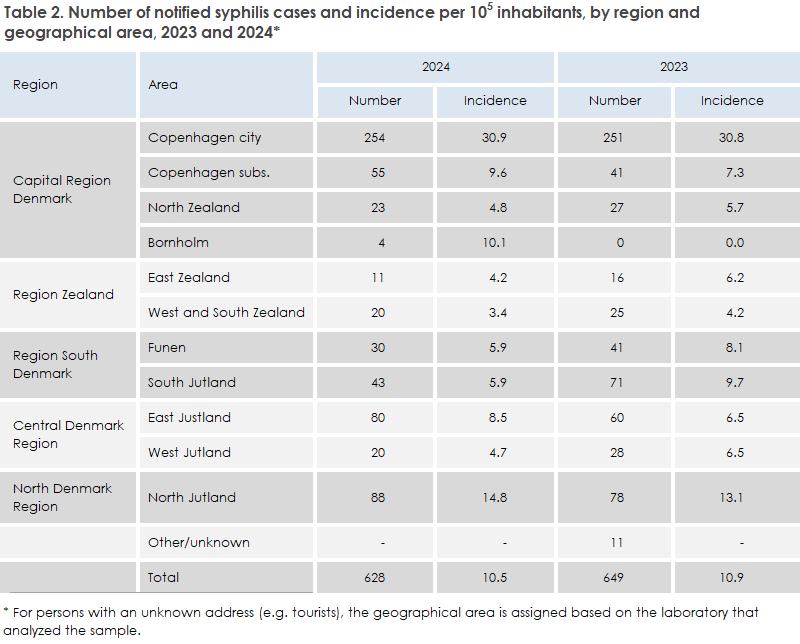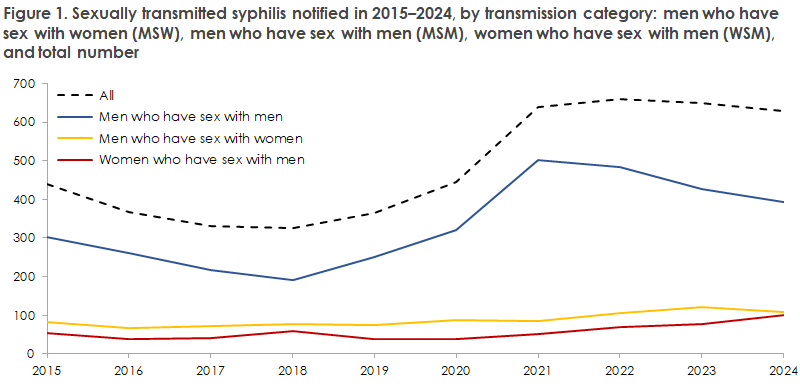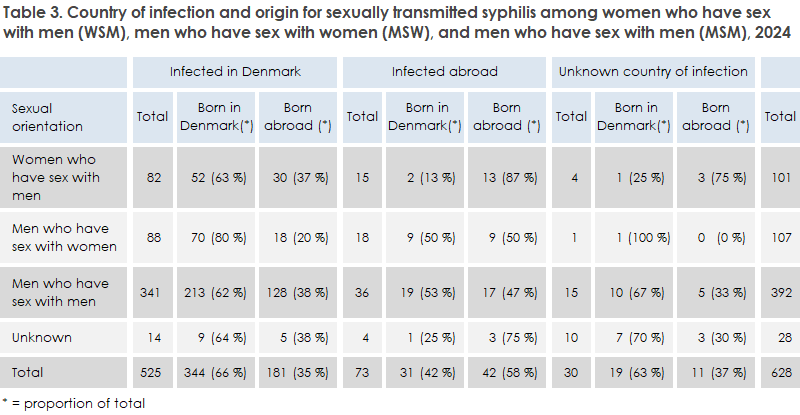Syphilis 2024
Syphilis 2024
Syphilis 2024
This report of syphilis cases in 2024 includes only notifications submitted via the Danish Health Data Authority’s Electronic Reporting System (SEI2).
In 2024, 628 cases of syphilis were notified via SEI2 to the Department of Infectious Disease Epidemiology and Prevention, Statens Serum Institut (SSI). Of these, 526 cases were among men and 102 among women, including two transgender women. The 628 cases involved 615 individuals, as 12 persons were notified with more than one occurrence during the year. In total, 164 of the cases notified in 2024 were among persons who had previously been notified with syphilis (including the 12 noted above with multiple notifications in 2024). Some individuals were notified repeatedly—up to 12 times.
The median age for men was 40.5 years (range 16–81 years) and for women 35 years (range 0–67 years), see Table 1.

As in previous years, the majority of the individuals resided in the Copenhagen area, see Table 2.


In 2024, a continued small decline was seen among MSM and a small increase among women who have sex with men (Figure 1).
Congenital syphilis and syphilis among pregnant women
A total of 15 pregnant women were found to be positive for syphilis. Eight of the 15 were born in Denmark and seven were born abroad. A confirmatory syphilis test was performed in 97% of women who were found positive on the screening test. Despite several reminders from SSI and/or their general practitioner, three women never had a confirmatory test performed.
One case of congenital syphilis was notified in 2024. An ethnically Danish woman, pregnant for the second time after a previously uncomplicated pregnancy and birth, who presented to the maternity unit at 37+2 weeks’ gestation with reduced fetal movements for 24 hours. On arrival, intrauterine fetal death (IUFD) was diagnosed. Previous ultrasound scans in the first and second trimesters had been normal, as were growth scans at weeks 30 and 35. The woman had been, as is recommended during pregnancy, screened for HIV, hepatitis, and syphilis in the first trimester, with negative results. Ten days before admission, screening tests were repeated by chance. Results of these tests came less than 24 hours before IUFD was diagnosed, and this time the test was positive for syphilis. The confirmatory test showed an active syphilis infection. For further details, see the article in Ugeskrift for Læger.
Transmission
Sexual orientation
Among the 526 notified men, 107 (20%) were reported as infected by women, 392 (75%) as infected by men (MSM), and 27 (5%) had no information on mode of transmission. Among women, 101 were infected by men, and there was one case of vertical transmission.
Of the 392 MSM notified with syphilis, 341 were infected in Denmark, of whom 213 were ethnically Danish. This means that 19 ethnically Danish MSM acquired syphilis while abroad.
Country of infection
For 598 (95%) of the notified cases, the country of infection was reported. Among these, 525 (88%) were infected in Denmark, of whom 344 were ethnically Danish. The remaining 73 were infected abroad, including 31 ethnically Danish persons. The most common countries of infection after Denmark were Germany, Spain and Greenland.
Country of infection and origin for the 628 cases with sexually transmitted syphilis are shown in Table 3.

Syphilis and HIV, and PrEP
For 564 syphilis notifications (90%), information on HIV status was available; among the 392 MSM this number was 384 (98%), among the 107 men infected by women 84 (79%), and among the 102 women 76 (75%). Among the 27 men with unknown mode of transmission, HIV status was available for 19 (70%).
For 95 of the syphilis notifications there was also an HIV notification: 91 were known HIV-positive and four were newly diagnosed. Among the 392 MSM, 86 (22%) also had HIV; 84 were known HIV-positive and two were newly diagnosed. Among the 107 men infected by women, two were known HIV-positive and one was newly diagnosed. Among the 102 women, there were two known HIV-positive cases and one newly diagnosed case. Among the 27 men with unknown transmission mode, three had known HIV.
Among the 469 cases notified as HIV-negative, 126 were reported to be on PrEP (pre-exposure prophylaxis, medicine taken to prevent HIV), the majority of these were among MSM. Six cases were referred for PrEP initiation.
This report is also covered in EPI-NEWS 36–37/2025.